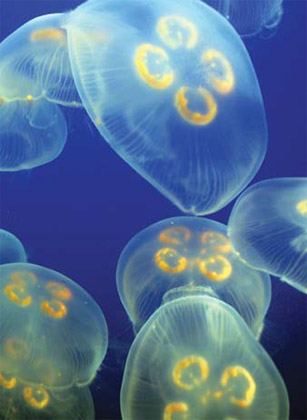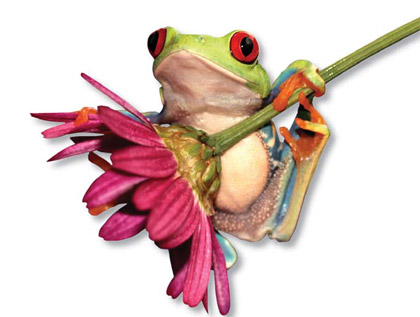Biodiversity and Life: Understanding the Connection
Biodiversity” makes headline news regularly because, according to the International Union for the Conservation of Nature (IUCN), “there is a growing recognition that diversity – biological as well as linguistic and cultural diversity – is the lifeblood of sustainable development and human welfare. Diversity is key to resilience – the ability of natural and social systems to adapt to change . . . In the western world, we’ve become so far removed from biodiversity that we’ve forgotten how much we use it in our daily lives and how seriously we’re affected by its loss.” In other words, many humans no longer experience firsthand how the natural world works. As a consequence, the planet’s natural systems, landscapes and cultures are being lost to the ever-increasing demands of development and consumerism.
Short for “biological diversity,” biodiversity refers to the marvel that Earth is literally teeming with an astounding genetic variety of life – plants, animals, people and habitats – everything from amoebas to zebras – all interconnected in a very fragile web. Each member plays an integral role in keeping life in balance, in making Earth inhabitable. Unfortunately, biologists and other researchers have seen increasing evidence that cumulative human impacts are launching a worldwide ecological catastrophe.
“At present, the world is losing plant and animal species at a rate between 100-1,000 times the natural extinction rates,” explains Ahmed Djoghlaf, Ph.D. and Executive Secretary of the United Nations Environment Programme’s Convention on Biological Diversity (UNEPCBD).
University of Chicago and Harvard University biologists predict that if extinctions continue at this pace, life will be in extreme jeopardy. To put this into perspective, mass extinction is not a loss limited to nature enthusiasts; it’s an earth-shattering injury for the human community. Species loss contributes to the growing global food crisis, destroys healthy ecosystems’ positive effects and diminishes genetic resource availability. Indeed, plant-based medicines that have provided treatments and cures for existing and newly discovered ailments may be the key to curing the world’s most devastating diseases. As an example, Digitalin and Digitalis, foxglove plant compounds, are drugs that combat congestive heart failure. Vincristine, used to treat acute childhood and chronic leukemia, Hodgkin’s and non- Hodgkin’s lymphoma, thyroid cancer, brain tumors and some blood disorders, is taken from Madagascar’s rosy periwinkle. And Taxol, from the Pacific Yew tree, is an effective anti-cancer chemotherapeutic agent.
Eric Chivian, M.D. and director of Harvard Medical School’s Center for Health and the Global Environment, wonders, “How many species like the Pacific Yew are being lost without ever knowing whether they contain wonder drugs?” Of the more than 15,000 medicinally based plant species used on Earth, 7,000 are likely threatened by over-harvesting or habitat loss, according to the IUCN.
The Impending Crisis
Over the past hundred million years the average extinction rate has been a handful of species per year, but today it “surpasses 3,000 species per year and is accelerating rapidly,” wrote the late Stephen M. Meyer, Ph.D., environmental activist and former MIT political science professor in his sobering 2005 essay “The End of The Wild.” Although Earth has experienced mass extinctions before, current losses are the result of human encroachment into other species’ natural habitats, according to Germany’s Helmholtz Association researchers.

© iStockphoto.com/ZoneCreative
As a result, biodiversity loss within the past 50 years is more rapid that at any other time in human history. IUCN experts report: “The world is losing its livestock breeds at an alarming rate, according to a 2007 report by the Food and Agriculture Organization of the United Nations (FAO). About 20 percent of the world’s breeds of cattle, goats, pigs, horses and poultry are currently at risk of extinction. At least one livestock breed a month has become extinct over the past seven years with their genetic characteristics lost forever . . . More than one in 20 of the Poaceae species – crops such as wheat, maize, barley and millet – are threatened with extinction. Just last year the wild apricot or Armeniaca vulgaris, the origin of all cultivated apricots, was classified as endangered on the IUCN Red List of Threatened Species.”
Meyer paints a bleak future for the planet: “The broad path for biological evolution is now set for the next several million years. And in a sense the extinction crisis – the race to save the composition, structure and organization of biodiversity as it exists today – is over and we have lost.”
Humanity’s Contribution
“Our species is having the most profound impact on biodiversity and in every conceivable way: altering the planet’s climate, reducing and changing habitats, emitting all sorts of harmful (non-greenhouse) pollution and disrupting historic predator/prey relationships,” says William (Bill) Snape III, J.D. and Senior Counsel for the Center for Biological Diversity.
Likewise, Europe’s largest terrestrial biodiversity research project, ALARM, with more than 200 scientists from 35 countries, is concerned with similar human drivers, which include “exotic” or alien plant and animal species invasions and a worldwide collapse of pollinator communities. (See this issue’s Climate Change Report, p. 54.) This destructive effect is most significant on habitat changes in the world’s 34 “hot spot” regions, two-thirds of which are tropical rainforests. These locations are home to more than half of the planet’s species even though they cover a mere 6 percent of Earth’s total surface area.
Unfortunately, globalization encourages developing nations’ inhabitants to rapidly cut, log and burn the planet’s most biologically rich regions for agricultural and biofuels development. In the past 40 years alone, 20 percent of South America’s Amazon rainforest has been destroyed. Likewise, Africa’s 800,000- square-mile Congo Basin jungle is undergoing similar destruction through development. Countries in every part of the world are not only reeling from the expected consequences of ecosystem destruction but also from the unexpected outcomes.

© iStockphoto.com/FinnBrandt
According to Karen Sudmeier-Rieux, an IUCN Commission on Ecosystem Management member, it’s time to learn “from past mistakes and let ecosystems play their role in protecting against natural disasters.” She observes in IUCN’s January 2008 article “A World Without Biodiversity?”: “Europe has for centuries developed protection forests by having previously deforested large tracts of mountainous areas and having experienced subsequent disasters . . . With increasing numbers of climate change-induced natural disasters . . ., we learn how poor management of biodiversity has exacerbated the impact on vulnerable populations: Hurricane Katrina and the destruction of the wetlands, the 2004 tsunami and the destruction of sand dunes and mangroves, landslides in Haiti following Hurricane Jeanne and deforestation, and, now, Kashmiri landslides and deforestation . . . Protective ecosystems and biodiversity are natural barriers to natural disasters . . . . ” Urbanization is another major contributor to habitat destruction and biodiversity loss. Approximately 50 percent of the global population presently resides in cities, and this demographic is increasing.
Djoghlaf laments: “By 2050 more than two-thirds of the world’s population will live in cities, which will require 150 new metropolises the size of New York City. Additionally, this development will be at the expense of agricultural land . . . likely to occur in developing countries where we still have a little biodiversity and untouched land left.”
Invasive alien or “exotic” plant and animal species are also a byproduct of urbanization and globalization. Vanishing native species are often replaced with species that “flourish in a variety of ecological settings, switch easily between food types, breed prolifically and, most significantly, have their needs met almost completely and efficiently by humans rather than by Mother Nature,” wrote Meyer. For example, raccoons, frequent pests to garbage can owners everywhere, exist five times more per square mile in developed areas versus in the wild. Other “urban exploiters,” such as rock doves, rats, house mice, white-tailed deer and insects like the cockroach, are almost entirely dependent upon human resources. Lack of predators and abundant human food subsidies create these enormous and unnatural “pest” population densities.
Natural resource overexploitation is another destructive behavior. Throughout history humans have disassembled terrestrial and aquatic ecosystems by eliminating the largest species at the food chain’s highest levels. Carl N. McDaniel, Ph.D. and Rensselaer Polytechnic Institute developmental biologist, proclaims people are now eliminating the few remaining land and aquatic predators, thus simplifying productive ecosystems to provide exclusively for themselves.
Djoghlaf concurs: “Take fish, for example; they’re not unlimited. Some experts predict that by 2048 all the oceans’ fish will disappear due to a number of factors, including – primarily – overexploitation.”
Biological Homogeneity
Once species extinctions occur and genetic diversity ebbs, the natural order is lost. Humanity has consistently hand-printed Earth to fit its needs. As a consequence, according to Meyer, “Forests are transformed to fields. Swamps are drained. Arid landscapes are irrigated. Mountains are flattened and valleys, filled. The bounty of nature is converted into commodities: timber, food, luxuries. Coexisting with nature always meant taming it, consuming it . . . as the human population jumped into the billions, the rise of human selection as the dominant evolutionary force was inevitable, and so was the end of the wild.”
This interference has produced an artificial and homogenous species selection with those species not required within this man-made order left behind. Human-induced extinctions caused by climate change, pollution, urbanization and other habitat changes, alien species introduction, overexploitation, globalization and artificial selection of specific crops and animals for agriculture have degraded the world’s ecosystems. As a result, natural services like fisheries, timber production, clean water supplies, waste management and detoxification, water purification, natural disaster protection, air quality, climate and erosion control are rapidly decreasing. And with it go countless cultural, spiritual, recreation and aesthetic benefits.
A “Biocultural” Philosophy

© iStockphoto.com/10four
According to Terralingua Co-founder and Director Dr. Luisa Maffi, “The diversity of life is biological, cultural and linguistic.” She adds: “Biodiversity and cultural diversity are intimately – some would say inextricably – related to each other. Humans have adapted to life in particular environments while drawing resources from those environments to sustain themselves . . . To a large extent, this has meant learning about stewardship and responsibility: how to use natural resources without depleting them and, often by enhancing them, how to preserve options for the future – in a nutshell, the very principle of sustainable development . . . .”
Ken Wilson, executive director of The Christensen Fund, concurs: “A new sense of how to go about conservation is arising from the realization that the future of biodiversity is inseparable from that of cultural and landscape diversity . . . Adopting an integrated framework for addressing the erosion of culture and nature will be hard . . . It means valuing the knowledge of indigenous and traditional people without romanticizing them. It means humbly asking to engage in their ways rather than having them turn up at our planning meetings . . . This will be as exciting as it is difficult. It will liberate a huge amount of knowledge, creativity and talent that has been silenced because we were so excited by what we had learned in the past century that we didn’t care what others had learned over the last 10,000 years. By moving away from costly top-down technocratic approaches, it will also enable a vast network of problem-solving local managers to tackle our global crisis and to honor the responsibilities inherent in their cultures to sustain creation’s renewal. “We need all the ideas we can get; no single hero or megafoundation is going to save the world for us. Maintaining diversity and resilience requires a diversity of approaches and methods. Without working to re-connect cultures with nature and values with place, biodiversity interventions will never save the planet.” (Maffi and Wilson’s excerpts from IUCN’s “A World Without Biodiversity?”)
A Paradigm Shift
Biodiversity loss is like losing insurance. Within an array of genetic and species diversity worldwide, Mother Nature provides a guarantee against destructive natural events because ecosystems adapt to disturbances. However, biodiversity loss is reducing ecosystem resilience. Most importantly, ecosystems and humanity are co-dependent.
Snape declares, “Humans will be a healthy species only if the full diversity of animal and plant species continues to accompany us through the journey of time.”
To insure the world’s future, Djoghlaf urges: “We need to have a paradigm shift in our perception between humans and nature. The illusion that services provided by nature – the air we breathe, the products we use, the forests, the fish – the perception that they’re unlimited and human beings can control and dictate nature with our technology, science and knowledge – this illusion should cease. These resources are very precious. Our life as human beings – a species among many other species – depends upon the services provided by nature. Each species on Earth has a role to play and is a part of the life-web of our own lives.”
In May 2008 in Bonn, Germany, the UNEPCBD created the first-ever global biodiversity forum. Djoghlaf generalizes: “We’re not going to stop the problems we face as humankind with only a few civil servants and a limited number of governments and ministries involved. We need to mandate biodiversity in government policies and have everyone in the global community involved . . . We need to have a different attitude – an attitude that respects nature and its products – an attitude that addresses all we do and all we consume.”
A recently released IUCN scientific survey on mammals compiled by 1,700 experts in 130 countries provides even more devastating news: One in four species is threatened with extinction, and one in two is declining.
The experts say “the situation is particularly serious for land mammals in Asia through the combined effects of overharvesting and habitat loss, and for marine species, victims of our increasingly intensive use of the oceans . . . But the results also show conservation can bring species back from the brink of extinction with 5 percent of currently threatened mammals showing signs of recovery in the wild.” As members of Earth’s community of life, humans have a choice to make. We can save our home, or we can continue to destroy it. “I think the bottom line is ‘what kind of a world do you want to leave your children?’” says Andrew Smith, Arizona State University School of Life Sciences professor.





























